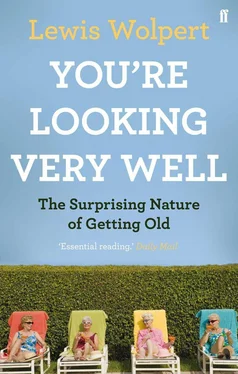Cells are very complex and there are at least 150 different proteins that are involved in repairing DNA when it is damaged. Other damage occurs in mitochondria that produce the energy for cellular activities, and in membranes that surround the cell and are also present internally. How long we, and other animals, can live is determined primarily through mechanisms that have evolved to regulate the levels of cellular damage in the body. As discussed earlier, it is only the germ cells which give rise to eggs and sperm for reproduction that do not age as the damage is repaired. Because our germ-line—the cells that give rise to eggs and sperm—gives rise to the next generation it must avoid any damage due to ageing. This requires elevated levels of maintenance and repair in germ cells, as compared with body cells. Some trees can live 5,000 years, the reason being that there is no clear difference between germ and body cells, so there are mechanisms to prevent ageing in all their cells.
How do body-cell repair processes deal with the chemical diversity of the molecular damage that is central to ageing? The forms that damaged molecules in the cell and environmental toxins can take are almost limitless. It is another example of the brilliance of evolution that a set of genes has evolved to code for proteins that deal with the near-infinite structural diversity of molecular junk that accumulates with age. The most common molecular sign of ageing in cells is an accumulation of altered proteins derived from erroneous synthesis and wrong folding. There are a number of special proteins which help cells deal with proteins that have folded wrongly and other faulty proteins, and which can delay ageing and extend lifespan in some organisms. Protein turnover is essential to preserve cell function by removing proteins that are damaged or redundant. There is evidence that an accumulation of altered proteins contributes to a range of age-related disorders, such as Alzheimer’s and Parkinson’s disease. People with two copies of the longevity variant of the CETP gene involved in lipid metabolism have been shown to have slower memory decline and a lower risk for developing dementia and Alzheimer’s disease
Cells can deal with the accumulation of damaged proteins and mitochondria due to ageing by eating bits of themselves—autophagy, the degradation of a cell’s own damaged components. Autophagy can destroy damaged cell structures like mitochondria, cell membranes and proteins, and the failure of autophagy is thought to be one of the main reasons for the accumulation of cell damage and ageing. During ageing, the efficiency of autophagy declines, and damaged cellular products accumulate. TOR (Target of Rapamycin) is a protein enzyme which controls metabolism and can stimulate cell growth but can also block autophagy. Inhibition of TOR by rapamycin can increase lifespan in model organisms. In the nematode worm there is clear evidence that lifespan is linked to the capacity to regulate autophagy. Results from the fly demonstrate that promoting expression of an autophagy gene in the nervous system extends lifespan by 50 per cent, thereby providing evidence that the autophagy pathway regulates the rate at which the tissues age. Recent studies have revealed that the same signalling factors regulate both ageing and autophagy, and this involves longevity factors like the sirtuins which were discovered in yeast.
Although ageing is a multifactorial process with many mechanisms contributing, anything that damages the DNA and so leads to absence of proteins or faulty proteins can cause a malfunction of the cells. Some of the most important mechanisms causing ageing may involve damage to DNA. Damage to DNA can cause a mutation which alters the coding for a protein. There is also DNA in mitochondria that produce the energy for the cell. DNA may be the structure whose integrity cells have the most difficulty in maintaining over their lifetime. The DNA in every chromosome experiences thousands of chemical modifications every day and there is often repair—removal of damaged bases in the DNA is estimated to occur 20,000 times a day in each body cell. While DNA damage has not been shown to cause ageing directly, a number of rare human disorders, caused by mutations in DNA repair genes, include symptoms of premature ageing.
Cells tend to respond to serious DNA damage by committing suicide—apoptosis—and this provides a way of preventing the damaged cell becoming cancerous. This occurs much more often in aged tissues in which the background accumulation of damage is greater, and the resulting loss of cells may itself accelerate ageing. Long-lived organisms probably invest in better DNA maintenance. The benefit of this is seen both in slower ageing and delayed incidence of cancer, since genome instability contributes to both these processes. Humans are less likely to get cancer than mice, as they have invested more in DNA repair. While long-lived organisms make greater investments in cellular maintenance and repair than short-lived organisms, with age the repair mechanisms fade.
Nature and evolution seem to have a fine sense of irony when they made our lives so dependent on oxygen, which is essential for energy production but may also be a major cause of ageing and our eventual death. One possible cause of the damage to DNA and other molecules that leads to ageing places much of the blame on small modified oxygen molecules. Oxygen is required by the mitochondria in cells to produce energy from the molecules derived from food. The production of ATP, the key energy source in cells, by the mitochondria results in the production of these reactive oxygen molecules. Free radicals like reactive oxygen are formed due to loss of an electron which they steal from another molecule, and which makes them unstable and able to damage other molecules. Severe reduction of mitochondrial function in worms shortens lifespan significantly, and a prime candidate has been damage caused by reactive oxygen. Certain dwarf mice live almost twice as long and this is due to reduction in damage to the mitochondria in their brains. Many long-lived mutants are resistant to oxidative stress, and species of mammals that live longer tend to have cells that, when tested in culture, are more oxidative stress resistant. Large animals produce reactive oxygen at a slower rate.
Even single-cell organisms like bacteria and yeast age. The critical requirement for ageing in unicellular organisms is that a parent cell, when it divides, provides a smaller, and essentially younger, offspring cell. This occurs in yeast and the simple bacterium E. coli , and they share having a visibly asymmetric division and an identifiable juvenile phase. E. coli divides down the middle, giving each daughter cell one newly regenerated tip. But the cell’s other tip is passed down from its mother, or grandmother, or some older ancestor. The cell that inherits the old tip exhibits a diminished growth rate, decreased offspring production, and an increased incidence of death. Thus the two apparently identical cells produced during cell division are in fact functionally asymmetric; the old cell should be considered an ageing parent repeatedly producing rejuvenated offspring. Asymmetric division may be a way for the cells to get rid of damage by dumping it into the older cell at division.
Yeast cells reproduce by the daughter cell budding off from the mother cell. After budding off some twenty daughter cells, the mother cell dies from what can be considered to be old age. Initially the mother cell buds every hour or so, but then the time between buds increases to three to four hours. Different strains of yeast age to different extents and the genes involved have been identified—the sirtuin (Silent Information Regulatory Two) genes. These genes are involved in life extension in a number of model organisms. In the nematode increased dosage of a sirtuin increases the mean lifespan by up to 50 per cent and involves the insulin signalling pathway. In flies, a sirtuin has also been reported to extend lifespan.
Читать дальше












